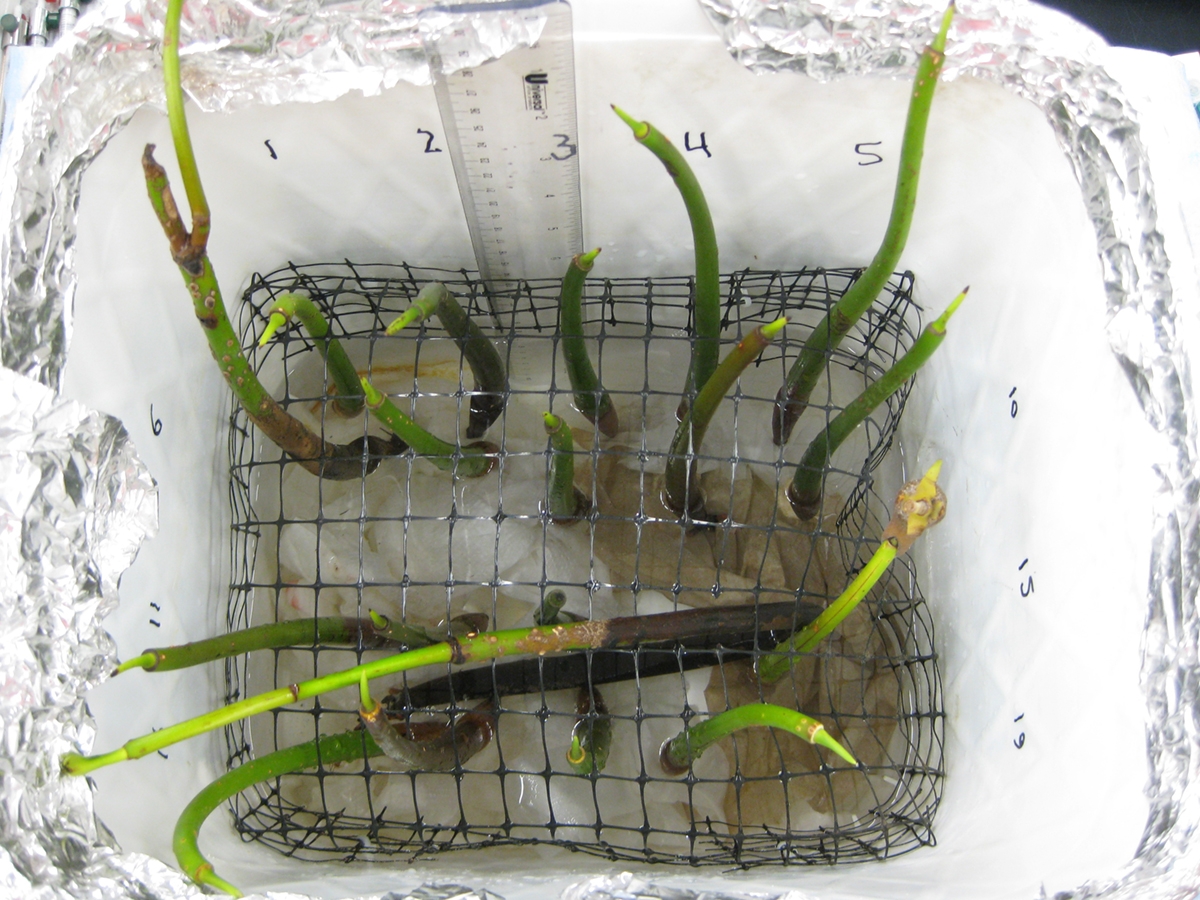MBL Greenhouse

Current Projects:
Water wranglers in the West -- How much water can sagebrush roots move up and down in soil?
Dr. Zoe Cardon and Dr. Rebecca Neumann
Observations of soil moisture in the dry Rush Valley, Utah landscape suggest that as much as ¾ of the rainwater falling each year may be redistributed very rapidly to deep soil not just by percolation but instead moved and "stored" deep by sagebrush roots. Sagebrush shrubs are common in Great Basin U.S. ecosystems, becoming more dominant with the increased grazing that has accompanied human settlement in the last 150 years. Water travels through the sagebrush roots, through miniscule, open pipes in the root centers, tending to equalize the water content of soil around the entire sagebrush root system. This redistribution of water is likely a major controller of hydrology at the landscape scale in Western ecosystems where sagebrush are dominant and water conservation is becoming more and more important. Cardon and colleagues are exploring just how much water is being moved through sagebrush roots, up and down in the soil, on BLM grazing lands near Laketown, Utah.
Water isn't the only limitation on plant productivity in such ecosystems, however. Nitrogen availability can also be sub-optimal, and Cardon and colleagues are also investigating how rates of nutrient cycling (and associated nutrient delivery to plants) catalyzed by soil microbes living among sagebrush roots are affected by root-mediated redistribution of water.
Sagebrush growing in the greenhouse are being prepared for further, controlled laboratory experiments exploring water redistribution by their root systems, and exploration of interactions among roots and soil microbes.
How do microbial communities develop on leaves?
Dr. Sheri Simmons and postdocs Lois Maignien and Emelia DeForce
Experiments with the model plant Arabidopsis thaliana are aimed at exploring the fundamental processes governing how microbial communities are structured, and in particular how they form and develop over time. Is this process repeatable? If so, on what level- do individual genes, functions, or phylotypes consistently appear at particular stages of development? Or is the structure determined largely by the identity of the first few colonists to reach a new habitat?
Simmons is developing the microbial community found on the leaves of Arabidopsis thaliana (the "phyllosphere") as a model system to address these questions. By growing many replicates of these model, fast-growing plants in the controlled environment of the MBL greenhouse, she will have the statistical power to investigate patterns in phyllosphere community structure. Additionally, she plans to conduct manipulative experiments to explore the effects of plant physiology and dispersal limitation on the phyllosphere community. Â Another line of investigation will explore whether the microscale distribution of microbes on leaf surfaces conforms to canonical "species-area" relationships found in macro-organisms.

How does excess nitrogen affect red mangrove growth and physiology?
Dr. Ivan Valiela and senior research technician Rich McHorney
The red mangrove (Rhizophora mangle) is one of the most widespread species of mangrove, and spans much of the tropical coastlines between 35oN and 35o S latitude. The seedlings develop the long initial "root" you see housed in white tubs in the greenhouse, and they are held by the parent tree until they are ready to root (an example of live-bearing in plants). After the seedling falls to the water below, it floats until it strands and begins to send out lateral roots. This behavior allows for rapid colonization of new areas. Seedlings germinated in early July 2010 and will be grown under a variety of enrichment treatments, and then their photosynthesis, water use, and other physiological characteristics will be measured. Valiela and McHorney are exploring questions such as:
- What kind of nitrogen source is preferentially taken up (ammonium or nitrate)?
- Are the rates of evaporation of water from the leaves affected by nitrogen supply?
- Is growth rate a function of N supply? These greenhouse experiments can be used to introduce SES students to tropical ecosystems, and also to point out applied issues such as the widespread eutrophication of coastal waters here on Cape Cod and in the tropics.
Live microbial "reports" from the soil grain
Dr. Zoe Cardon
Many soil functions, such as recycling of nutrients and processing of pollutants, are driven in large part by soil microbes. Variation in environmental conditions at the microscopic scales experienced by soil microbes over time strongly influences microbial activity and distribution. But, it is extremely difficult, if not impossible, to measure local environmental conditions at micrometer scales using traditional measurement techniques. In response to this problem, Cardon and colleagues are designing living microbes to report, in real time and from their natural soil habitat, what those microbes perceive as the environmental conditions and how they are responding to those conditions. These genetically engineered, living microbiosensors report "live, from the soil grain" by producing light signals via bioluminescence. The light is detected by an astronomy camera that is viewing the soil through glass-sided pots in which plants are growing. Experiments to date have focused on:
- sugars lost from plant roots and detected at tiny scales by bacterial microbiosensors;
- bacterial growth rates (an indicator of resource availability) in different areas of the plant root system;
- water uptake and water loss by plant roots to the surrounding soil.
The overall goal of the work underway is to better understand how plant roots and soil microbes interact to affect the "ecosystem services" such as nutrient cycling and decomposition that we humans depend on, as well as to better interpret the functional synergy between plant roots and soil microbes across diverse ecosystems.
More Information?
Because it is a research facility, the greenhouse is not open to the public, but please contact Zoe Cardon if you would like more information.